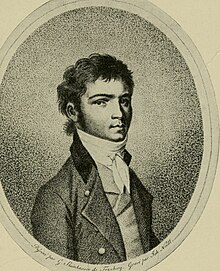This is an old revision of this page, as edited by Opus33 (talk | contribs) at 07:11, 6 December 2024 (revert edit made without citing any reference source). The present address (URL) is a permanent link to this revision, which may differ significantly from the current revision.
Revision as of 07:11, 6 December 2024 by Opus33 (talk | contribs) (revert edit made without citing any reference source)(diff) ← Previous revision | Latest revision (diff) | Newer revision → (diff) 1798 sonata by Ludwig van Beethoven| Piano Sonata No. 8 | |
|---|---|
| by Ludwig van Beethoven | |
 1801 engraving by Johann Joseph Neidl, after a now-lost portrait of Beethoven by Gandolph Ernst Stainhauser von Treuberg, ca. 1800 1801 engraving by Johann Joseph Neidl, after a now-lost portrait of Beethoven by Gandolph Ernst Stainhauser von Treuberg, ca. 1800 | |
| Key | C minor |
| Opus | 13 |
| Composed | 1798–1799 |
| Dedication | Prince Karl von Lichnowsky |
| Duration | 17-20 minutes |
| Movements | 3 |
Ludwig van Beethoven's Piano Sonata No. 8 in C minor, Op. 13, commonly known as Sonata Pathétique, was written in 1798 when the composer was 27 years old and was published in 1799. It has remained one of his most celebrated compositions. Beethoven dedicated the work to his friend Prince Karl von Lichnowsky. Although commonly thought to be one of the few works to be named by the composer himself, it was actually named Grande sonate pathétique (to Beethoven's liking) by the publisher, who was impressed by the sonata's tragic sonorities.
Prominent musicologists debate whether or not the Pathétique may have been inspired by Mozart's piano sonata K. 457, since both compositions are in C minor and have three very similar movements. The second movement, "Adagio cantabile", especially, makes use of a theme remarkably similar to one in the spacious second movement of Mozart's sonata. Close similarities have also been noted with Bach's Partita no. 2 in C minor. Both works open with a declamatory fanfare marked Grave, sharing a distinct combination of dotted rhythms, melodic contour, and texture. Furthermore, the first four notes of the Partita's Andante (G–C–D–E♭, prominently repeated throughout the work) are found in the Pathétique as the first notes of important themes – first in the hand-crossing second subject of its first movement (initially transposed), then in the main theme of the Rondo. It is known that Beethoven was familiar with the works of Bach, studying The Well-Tempered Clavier as a youth and returning to his predecessor's compositional styles later in life.
Movements
I. Grave – Allegro di molto e con brioII. Adagio cantabile
III. Rondo: Allegro Performed by Paul Pitman
In its entirety, encompassing all three movements, the work takes approximately 18-20 minutes to perform.
The sonata consists of three movements:
- Grave (Slowly, with solemnity) – Allegro di molto e con brio (Very quickly, with vigour)
- Adagio cantabile (Slowly, in a singing style)
- Rondo: Allegro (Quickly)
Grave – Allegro di molto e con brio
The first movement is in sonata form. It begins with a slow introductory theme, marked Grave. The exposition, marked Allegro di molto con brio, is in
2 time (alla breve) in the home key of C minor and features three themes. Theme 1 features an aggressive rocket theme covering two octaves, accompanied with constant tremolo octaves in the left hand. Beethoven then makes use of unorthodox mode mixture, as he presents theme 2 in E♭ minor rather than its customary parallel major. This theme is more lyrical than the first and makes use of grace notes and crossed hands. Theme 3 modulates to the mediant, E♭ major, and features an Alberti-type figuration for the bass with tremolo. A codetta, with ideas from the opening allegro, closes the section. Some performers of the sonata include the introduction in the repeat of the exposition (Rudolf Serkin and András Schiff, for example), but most return to the beginning of the allegro section. This movement is one of the few compositions that contain hundred twenty-eighth notes.
The development section begins in the key of G minor but quickly modulates to E minor. In this section, Beethoven extends Haydn's compositional practice by returning to the introductory section. After this reappearance of the Grave, the composer generates suspense with an extended dominant preparation.
The recapitulation brings back the themes of the exposition in different keys: themes 1 and 3 are played in the tonic key of C minor, then theme 2 is played in the unexpected key of F minor but then returns to the tonic key. The coda is very dramatic and includes a brief reminder of the Grave before ending with a swift cadence.
The opening has been sampled and featured in countless works; for instance, Lady Gaga used the theme in the intro to the music video for her 2011 song "Marry the Night."
MIDI rendition, 6:57 minutes, 30 KB
Adagio cantabile
This movement exemplifies the expressive Adagio style of many slow movements in the classical period. The famous cantabile melody is played three times, always in A♭ major, separated by two modulating episodes; the movement is thus a simple rondo rather than the sonata form more common for movements of this seriousness. The first episode is set in F minor (the relative minor of A♭ major), further modulating to E♭ major before returning to the main theme. The second episode begins in A♭ minor and modulates to E major. With the final return of the main theme, the accompaniment becomes richer and takes on the triplet rhythm of the second episode. There is a brief coda.
MIDI rendition, 5:03 minutes, 12 KB
The main theme of this movement opens nearly identically to an episode in the slow movement of Mozart's Piano Sonata No. 14, K. 457.
Rondo: Allegro
The sonata closes with a cut time movement in C minor. The main theme closely resembles the second theme of the Allegro of the first movement: its melodic pattern is identical for its first four notes, and its rhythmic pattern for the first eight. There is also a modified representation of the melody from the second movement, so it connects all three movements together. The movement's sonata rondo form includes a brief coda. The three rondo episodes are in E♭ major, A♭ major, and C major. The common use of sforzando creates a forceful effect.
MIDI rendition, 4:25 minutes, 17 KB
Reactions of Beethoven's contemporaries
The sonata Pathétique was an important success for Beethoven, selling well and helping create his reputation as a composer, not just as an extraordinary pianist. Not only was it instantly popular, it also exposed the world to the characteristics that Beethoven would continue to develop in the coming years.
When the pianist and composer Ignaz Moscheles discovered the work in 1804, he was ten years old; unable to afford to buy the music, he copied it out from a library copy. His music teacher, on being told about his discovery, "warned me against playing or studying eccentric productions before I had developed a style based on more respectable models. Without paying heed to his instructions, however, I laid Beethoven's works on the piano, in the order of their appearance, and found in them such consolation and pleasure as no other composer ever vouchsafed me."
Anton Schindler, a musician who was a friend of Beethoven in the composer's later years, wrote: "What the Sonate Pathétique was in the hands of Beethoven (although he left something to be desired as regards clean playing) was something that one had to have heard, and heard again, in order to be quite certain that it was the same already well-known work. Above all, every single thing became, in his hands, a new creation, wherein his always legato playing, one of the particular characteristics of his execution, formed an important part."
In popular culture
The cantabile theme from this movement was used as the theme music for radio's most widely listened-to classical music program, Adventures in Good Music, which aired nationally in the United States and in many other countries from 1970 to 2007. The theme was performed by Karl Haas, the program's host.
The full second movement is depicted as being performed by Schroeder in the movie A Boy Named Charlie Brown. (The actual performance is done by Ingolf Dahl.)
Additionally, Billy Joel used the theme as the chorus of his 1983 song "This Night"; as did Louise Tucker in her Midnight Blue from 1982, which was a #1 hit in France.
See also
References
- ^ Craig Wright, Listening to Western Music, pp. 209–212. Cengage Learning.
- Beethoven Pathetique Sonata Op. 13 All About Beethoven. Retrieved May 1, 2008.
- Burkhart, Charles: Anthology for Musical Analysis, p. 233. Schirmer 2004.
- Marks, F. Helena. The Sonata: Its Form and Meaning as Exemplified in the Piano Sonatas by Mozart. W. Reeves, London, 1921.
- Sisman, Elaine R. Pathos and the Pathetique: Rhetorical Stance in Beethoven's C-minor Sonata Op. 13. Beethoven Forum vol. 3, pp. 81–106. University of Nebraska Press, 1994.
- "Beethoven: Sonata No.8 in C Minor, Op.13, "Pathétique" (Daniel Barenboim) | Score video". YouTube. 21 June 2022.
- Maynard Solomon, Beethoven, p. 80. Revised Edition, Schirmer Trade Books.
- Jan Swafford, Beethoven: Anguish and Triumph, p. 219. Houghton Mifflin Harcourt
- ^ H. C. Robbins Landon, Beethoven: A Documentary Study, pp. 61–62. Thames & Hudson 1970.
- Anne Midgette (February 8, 2005). "Karl Haas, Radio Ambassador of Classical Music, Dies at 9". The New York Times. Retrieved June 8, 2023.
- Holley, Joe (8 February 2005). "Classical Radio Personality Karl Haas, 91, Dies". The Washington Post. p. B06. Retrieved 17 November 2008.
- "Did you know Billy Joel's 'This Night' uses the same melody as Beethoven's Sonata Pathétique?".
External links
- Piano Sonata No. 8: Scores at the International Music Score Library Project
- Score from the Ricordi edition, William and Gayle Cook Music Library at the Indiana University School of Music
- Public-domain recording of this sonata at Musopen
- A lecture by András Schiff on Beethoven's piano sonata Op. 13, via The Guardian
- Recording by Daniel Barenboim


